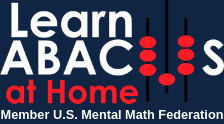
In this age of calculators, computers, machine learning and AI, why are we still talking about Abacus and Mental Math (aka Mind Math)?
We are talking about it because it is still as relevant as it was before. Probably even more so now because of all the technology our children can access in and out of the classroom that gives them shortcuts to the detriment of building their math proficiency and a strong math foundation.
If you are into working out and have ever used a personal trainer or looked online for tips, experts always talk about building a strong core to avoid injury and improve results over the long term. Once that core is strong, they add other exercises to the workout routine to accelerate results.
Similarly, with investing, financial advisors talk about having a strong core portfolio built for stability and long-term growth before considering individual stock investments or speculating in the next get-rich-quick stock.
Our children’s education is no different.
By investing in them to build that strong core i.e. a strong math foundation at an early age you are setting your child up for success in the long term. By having that strong core, they will have the confidence to take on new challenges as they advance through schools and beyond.
Abacus Mind Math helps your child build computational fluency which is at the core of a strong math foundation. It is most effective when started at a younger age, generally between 5-12 years of age.
Even better news is that it does not require a huge time or financial commitment to see results. A child begins to see results in under 6 months of starting the program and a typical program is only between 18-24 months to develop amazing mind math abilities as highlighted in this YouTube video.
Besides computation fluency, there are a number of other unique benefits of Abacus Mind Math that gives children a leg up for the rest of their lives. We explore some such key benefits of Abacus Mind Math in this article.
Build a Strong Math Foundation
Strong math foundation means different things to different people and also varies by age of the child. However, as we discussed, at the core of a strong math foundation is fluency in performing four main math operations of addition, subtraction, multiplication and division with great speed and accuracy. Furthermore, Mental Math is the ultimate in math fluency and a child is able to achieve that goal faster with Abacus Mind Math than through any other method.
But how do you measure computational fluency? What are we shooting for and how fast is fast enough?
According to research by Kling & Bay-Williams, a child has mastered a math fact if they can produce an answer within 3 seconds, through either recall or by applying a highly efficient strategy.
Children are typically able to beat the 3 second mark hands down with Abacus Mind Math. In fact, within just a few months, they are able to calculate in their head with great speed and accuracy as demonstrated in the video above.
Improve Visualization and Big Picture Thinking
For those of us not in the medical field, we’ve all seen enough pictures to know that our brains have a vertical ridge running down the center of our brains that divides it into almost two equal sections. One section is called the Left Hemisphere or Left Brain and the other section is called the Right Hemisphere or Right Brain. Although they look very similar, they are very different in the functions they perform.
With that said, it’s important to understand that both sides of the brain are important and work together all the time. However, there are some interesting differences in how they operate. The left brain is sequential in nature. It is logical and analytical. What and how we learn in school stimulates and exercises the left side of the brain primarily. On the other hand, the right brain is Simultaneous in nature. It has the ability to see the big picture and interpret things contextually.
Said differently, we can also say that Left Brain is about knowledge while the Right Brain is about Creativity, Big Picture thinking, Focus, and Concentration.
In his book “A Whole New Mind. Why Right Brainers Will Rule the World”, the author Daniel Pink explains that in the global economy today where knowledge work (left brain activity) is exceedingly outsourced, it is important to exercise the right brain just as much to develop creativity and outside the box thinking.
Improve Focus & Concentration
There is an old Chinese proverb that translates to:
“When I hear, I forget. When I see, I remember. When I do, I understand.”
This was true then, and it is true now. When a child learns by engaging multiple senses (and not just sitting listening to a teacher in class), they learn and understand better.
When a child practices Abacus Mind Math, they engage multiple senses of sight, touch and hearing to achieve amazing Mind Math Fluency.
Furthermore, by learning Mind Math, a child also improves their listening and visualization skills which leads to improvement in their ability to focus and concentrate.
If you’ve watched any child performing mind math drills, you can only imagine the level of focus and concentration that’s involved as they listen to long string of numbers being called out at a rapid speed while simultaneously manipulating the beads in their mind to calculate the answer.
Very Impressive!
Improve Memory & Retention
Children performs Mind Math by visualizing pictures of the beads on the Abacus in their mind. Since people remember pictures better than words, picturing the Abacus helps the child calculate with amazing speed and accuracy.
As a result, their memory and the ability to retain information improves making it easier for children to learn and retain information.
Improve Problem Solving & Critical Thinking Abilities
If you search for the definition of Critical Thinking, you will find a number of definitions, each one wordier (and sometimes confusing) than the other.
In my opinion, Critical thinking is the ability to apply common sense to analyze the situation/problem by “seeing” the big picture to reach a conclusion.
This real life example may help explain this better – you need to get from point A to point B by certain time and have different options to get there – by train, by bus or by cab. Depending on what is important to you – getting there in time; or getting there at the lowest cost possible; or getting there on time at the lowest cost, you may pick one or more travel modes.
Hope that puts things into perspective. Being able to analyze and visualize the big picture is key to critical thinking.
And guess what?
Visualizing happens to be one of the key skills that develop when studying Abacus Mind Math.
Improve academic performance in all subjects, not just math
It’s pretty obvious by now how Abacus Mind Math helps the child develop a strong Math Foundation that leads to Math Success throughout school and beyond.
But it doesn’t stop there.
Since the child has improved their power to visualize and retain information, this translates into better performance not only in Math but also other subjects, even those that require rote memorization.
Conclusion
Brain is built, not born!
Brain cells are formed before birth, but the connections in the brain, which in effect is the wiring that forms the architecture happens during early childhood. And how that wiring is formed, depends on each child’s interactions with the world around them.
Exercising the brain with Abacus Mind Math at an early age develops and strengthens the connections that help the child develop not only amazing mental math abilities, but also benefits from improved focus, concentration, big picture thinking, and ability to retain information.
Benefits to Abacus Mind Math to its students are many. Sign up for a 7 Day Free trial and schedule your complimentary orientation call today.
